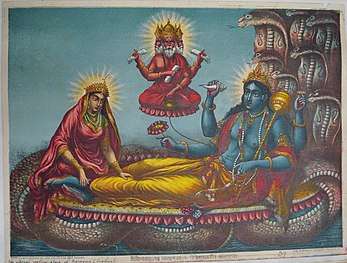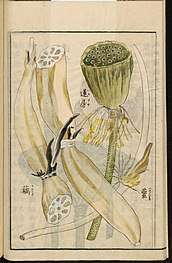Sacred lotus in religious art
The lotus, Nelumbo nucifera, is an aquatic plant that plays a central role in the art of Indian religions such as Hinduism, Buddhism, Sikhism, and Jainism.

In Asian art a lotus throne is a stylized lotus flower used as the seat or base for a figure. It is the normal pedestal for divine figures in Buddhist art and Hindu art, and often seen in Jain art. Originating in Indian art, it followed Indian religions to East Asia in particular.
Hinduism
Hindus revere it with the divinities Vishnu and Lakshmi often portrayed on a pink lotus in iconography; historically, many deities usually sit on a stylized lotus throne. In the representation of Vishnu as Padmanabha (Lotus navel), a lotus issues from his navel Brahma on it. The goddess Saraswati is portrayed on a white-colored lotus. The lotus is the symbol of what is divine or immortality in humanity, and is also a symbol of divine perfection. The lotus is the attribute of sun and fire gods. It symbolizes the realization of inner potential and in Tantric and Yogic traditions the lotus symbolizes the potential of an individual to harness the flow of energy moving through the chakras ( often depicted as wheel like lotuses) flowering as the thousand -petaled lotus of enlightenment at the top of the skull.[1]
Vishnu is often described as the "Lotus-Eyed One" (Pundarikaksha).[2] The lotus's unfolding petals suggest the expansion of the soul. The growth of its pure beauty from the mud of its origin holds a benign spiritual promise. In Hindu iconography, other deities, like Ganga and Ganesha are often depicted with lotus flowers as their seats.
The lotus plant is cited extensively within Puranic and Vedic literature, for example:
One who performs his duty without attachment, surrendering the results unto the Supreme Lord, is unaffected by sinful action, as the lotus is untouched by water.
— Bhagavad Gita 5.10:
Chinese religions
In Chinese culture, Confucian scholar Zhou Dunyi 1017–1073) wrote:
I love the lotus because while growing from mud, it is unstained.
The lotus is the emblem of Macau and appears on its flag.[4]
Buddhism
In the Aṅguttara Nikāya, the Buddha compares himself to a lotus (in Pali, paduma),[5] saying that the lotus flower raises from the muddy water unstained, as he raises from this world, free from the defilements taught in the specific sutta.[6][7]
In Buddhist symbolism, the lotus represents purity of the body, speech and mind, as if floating above the murky waters of material attachment and physical desire. According to legend, Gautama Buddha's first steps made lotus flowers appear everywhere he stepped.[8] In Tibet, Padmasambhava, the Lotus-Born, is considered the Second Buddha, having brought Buddhism to that country by conquering or converting local deities; he is normally depicted holding a flower.[9] Lotus thrones are the normal pedestal for most important figures in Buddhist art.
Jainism
The founders (tirthankaras) of Jainism are portrayed seated or standing on lotus thrones.[10] As his name suggests, the Jain tirthankara Padmaprabha is also represented by the symbol of a lotus. Padmaprabha means 'bright as a red lotus' in Sanskrit. It is said in Śvetāmbara sources that his mother had a fancy for a couch of red lotuses – padma – while he was in her womb.[11]
Bahá'í
The international Bahá'í community adopted the symbolism of the lotus in the design of the Lotus Temple in New Delhi, India.[12]
Cultural
In the classical written and oral literature of many Asian cultures the lotus is present in figurative form, representing elegance, beauty, perfection, purity and grace, being often used in poems and songs as an allegory for ideal feminine attributes. In Sanskrit the word lotus (पद्म padma) has many synonyms: since the lotus thrives on water, ja (denoting birth) is added to words for water to derive synonyms for lotus, like rajiv, ambuja (ambu (water) + ja (born of)), neerja (neera (water) + ja (born of)), pankaj, pankaja, kamal, kamala, kunala, aravind, arvind, nalin, nalini and saroja and names derived from the lotus, like padmavati (possessing lotuses) or padmini (full of lotuses). These names and derived versions are often used to name girls, and to a lesser extent boys, throughout South and Southeast Asia.[13][14]
The lotus flower is the state flower of several Indian states, including Karnataka, Haryana, and Andhra Pradesh.[15] The lotus flower is the election symbol of the Bharatiya Janata Party, one of the two major political parties in India.[16]
 Hindu goddess Lakshmi holding and standing on a lotus
Hindu goddess Lakshmi holding and standing on a lotus Vishnu rests on the serpent Ananta while Brahma sits on a lotus throne, the plant emitting from Vishnu's navel.
Vishnu rests on the serpent Ananta while Brahma sits on a lotus throne, the plant emitting from Vishnu's navel..jpg) The boy Buddha rising up from a lotus. Crimson and gilded wood, Trần-Ho dynasty, Vietnam, 14th-15th century
The boy Buddha rising up from a lotus. Crimson and gilded wood, Trần-Ho dynasty, Vietnam, 14th-15th century
 Illustration from the Seikei Zusetsu Leiden University Library, Ser. 1042
Illustration from the Seikei Zusetsu Leiden University Library, Ser. 1042
See also
- Lotus position
- Ashtamangala (Eight Auspicious Symbols)
References
- Tresidder, Jack (1997). The Hutchinson Dictionary of Symbols. London: Duncan Baird Publishers. p. 126. ISBN 978-1-85986-059-5.
- "Lotus-eyed One". The Hindu. 12 July 2013.
- "周敦颐:《爱莲说》". Book.qq.com. Archived from the original on 2012-04-25. Retrieved 2012-11-14.
- Lao-Phillips, Jenny (8 June 2017). "Lotus Flower: luck, purity or a flash in the pan". Macau Daily Times.
- Wisdom Library -Paduma
- AN 10.81, '"Bāhuna suttaṃ".
- AN 4.36, "Doṇa suttaṃ".
- Getty, 15
- "The Second Buddha: Master of Time". Frances Young Tang Teaching Museum and Art Gallery. 2019.
- http://www.mahavidya.ca/2016/04/22/the-sacred-lotus-symbol/
- Balbir, Nalini. "Padmaprabha". JainPedia. Retrieved 29 November 2019.
- "Architecture of the Bahá'í House of Worship". National Spiritual Assembly of the Bahá'ís of India. 2012. Retrieved 29 November 2019.
- "Indian baby names". Pitarau. Archived from the original on 2 December 2010.
- "Sanskrit-based names". Behind the Name.
- State Flower of Haryana, Karnataka Archived 10 April 2017 at the Wayback Machine
- "Bharatiya Janata Party (BJP)". Elections.in. Retrieved 16 September 2019.
Further reading
- Dallapiccola, Anna L. (2002). Dictionary of Hindu Lore and Legend. New York: Thames & Hudson. ISBN 0-500-51088-1.
- Lawlor, Robert (1991). Voices Of The First Day: Awakening in the Aboriginal Dreamtime. Rochester, Vermont: Inner Traditions. ISBN 0-89281-355-5.
- Shakti, M. Gupta (1971). Plant Myths and Traditions in India. Netherlands: Brill Publishers. pp. 65–67.
External links

